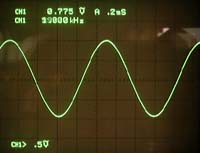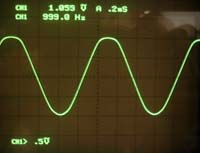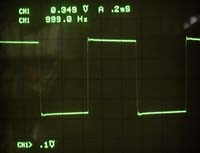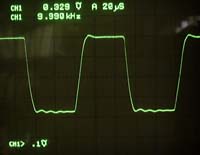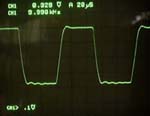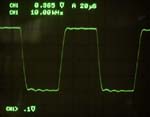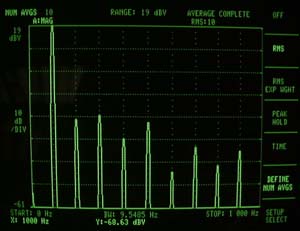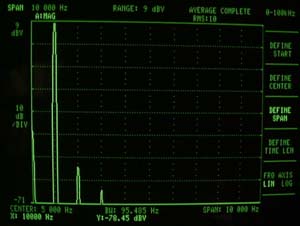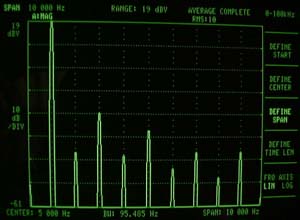Application Notes
2A3 Push-Pull 20W Monaural Power Amplifier
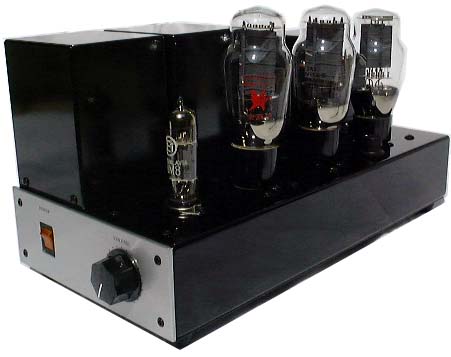
This section introduces one example using R core audio interstage and output transformer: 2A3 push-pull 20W monaural power amplifier. Maximum output of this amplifier is 20W that is quite enough for family use. The main features are excellent performances (low distortion, wide bandwidth, high output, and low noise level) that are difficult to be achieved by the single-ended amplifier, and good sound quality straightforward that is particularly characterized by interstage transformer coupled circuit.
Rated performance of 2A3 push-pull 20W monaural power amplifier
|
Maximum output |
20W |
|
Frequency bandwidth (1W) |
10Hz to 55KHz +0,-3db |
|
Damping factor |
3.8 |
|
Distortion factor (1KHz) |
1W : 0.055%, 10W : 0.6.%, 20W : 3.2% |
|
Residual noise level |
0.1mV (without weighting network) |
Sovtek 2A3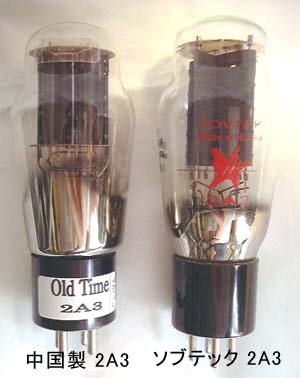
For this amplifier, we used 2A3 made by Sovtek, Russia.
Different to popular 2A3 made by RCA or in China that have two electrode units
in parallel connection, Sovtek 2A3 has a single electrode very similar to 300B.
Overall dimensions are also one size larger than ordinary 2A3.
The published rating is the same as ordinary 2A3, but in a practical sense, it
seems to have an extra power handling capacity. The quadruple that we used this
time are well matched and have no irregular faint noises that are heard occasionally
with 2A3 made in China.
Main rated characteristics of the tube are as follows.
|
Plate dissipation |
15W |
|
MU |
4.2 |
|
Mutual conductance |
5250uS |
|
Plate resistance |
800ohms |
|
Maximum plate voltage |
300V |
|
Filament voltage |
2.5V |
|
Filament current |
2.5A |
Design objective of Amplifier
The design objectives of this amplifier are: high performance, easiness for collecting component parts, and easiness for building the amplifier.
- To break through the bandwidth of conventional interstage transformer coupled circuit by using high-performance output and interstage transformer
- To drive up to the grid + field of 2A3 by interstage transformer to obtain high output 20W.
- To achieve a low distortion first by push-pull output stage and further low distortion by distortion canceling technique with driver stage
- To achieve a low noise level by DC power supply to the filament of output tube
- To combine successfully high-performance characteristics and good sound quality
- To configure with easy-to-collect multipurpose parts in the market
- To select monaural construction to downsize the weight and dimensions for easy-building
Amplifier Configuration
1.Overall
configuration
6BM8: triode unit for voltage
amplification stage -- 6BM8: pentode unit in triode connection driver -- interstage transformer -- 2A3 fixed bias -- push-pull output transformer 5Kohms.
The voltage amplification stage and driver use 6BM8 that is well-known
as triode-pentode multiple-unit small power tube.
2. Output stage
The tube operation is class A2 push-pull that is driven up
to grid + field in order to obtain the power efficiently out of 2A3 whose plate
dissipation is 15W. Plus, fixed bias system is employed for efficient use of
the supply power voltage.
The operating condition of the output stage is as follows.
|
Plate voltage |
320V (at 0 input), 290V (at max. output) |
|
Plate current |
80mA (for 2 tubes) |
|
Grid voltage |
-65V |
|
Load |
5Kohms(between P-P) |
Up to about 12W, the operation is class A1 and from 12W and
above class A2 that is driven into grid + field. Since the grid current flows in
grid + field, a powerful driver stage is necessary not to suffer the grid
current and to supply high voltage.
Output transformer is RX-40-5.
3. Fixed bias circuit using MOS-FET
The fixed bias circuit must absorb the grid current flowing in the grid
of 2A3 not only supplies the negative voltage for biasing the grid of 2A3.
When the grid is swung into grid + field, the signal is rectified by the
grid and thus generating DC component. By this, the grid voltage goes further
to negative side, which reduces the plate current and thus suppresses the
output increase. In order to increase efficiently the output power, the
fixed bias circuit must retain the bias voltage constant even if the grid
current flows. In this amplifier, an MOS-FET source follower circuit is
installed after the normal fixed bias circuit to absorb the grid current.
The reason of lay-outing Nch MOS-FET on the opposite side to the general
voltage regulator source follower is that the grid current works to increase
the bias voltage not to decrease it. Nch MOS-FET consumes the current from
the grid that works to increase the bias voltage and thus keeps the voltage
on the grid constant.
4. Driver stage
The combination of 6BM8 pentode unit in triode connection
and RC-20 interstage transformer obtains
high power without being affected by the grid current. The connection of RC-20
interstage transformer is primary in series and secondary in push-pull
connection. Phase inversion is made by 1: 0.9+0.9 and amplification operation
by 1:1.8. The secondary of RC-20 is open (without load). This enables both to
obtain the natural and unconstrained sound quality proper to open operation and
to feed entire supply current from the interstage transformer to the grid of
power tube.
The operating condition of 6BM8 pentode unit is effective plate voltage 190V,
plate current 10mA.
5. Voltage amplification stage (first
stage)
The voltage amplification stage uses 6BM8 triode unit. Plate load resistance is 100Kohms, putting the unit on a standard operating condition. This unit is directly coupled with the next driver stage. High-cut filter made up with 10Kohms and 50pF and provided at the top of input is for suppressing incoming high-frequency noise or leakage noise from SACD.
6. Negative feedback
The gain of this amplifier without negative feedback is 65, being considerably high for use. Besides, the damping factor is about 1.5 because of the combination of the plate resistance of 2A3 being sufficiently low but with the output transformer of 5Kohms load between P-P. Thus, the damping at low frequency would be poor.
So, we employ negative feedback to reduce the gain and increase the damping
factor. After providing 12dB of NFB, the gain will become 16, quite appropriate
to use. However, it is practically difficult to provide an overall negative
feedback 12dB to the circuit including two transformers: interstage and output
transformer.
Therefore, for this amplifier, we have employed both 6dB minor negative feed
back from the plate of driver tube 6BM8 pentode in triode connection, and 6dB
major negative feedback from the speaker terminal of the output transformer.
With 6dB major negative feedback, the damping factor is appropriately set about
3.8.
Major and minor negative feedback presents a very stable Square wave response
in spite of the circuitry including two transformers.
7. Power supply
Power transformer is a reasonable multipurpose transformer PCM-170M of Noguchi. DC 325V is obtained by diode center tap rectification of AC 290V. Choke coil is a multipurpose PCM-1520 of Noguchi. Electrolytic capacitor 400V 100uF is a small-sized general purpose radial type made by Unicon that has once been distributed by Softone.
Negative voltage supply for fixed bias is –100V that is made from
AC 70V half-wave rectification.
Power supply 2.5V 2.5A for 2A3 filament is DC to reduce hum noise level.
Two lines of DC2.5V are obtained each by bridge rectification of two windings
of 3.8V 3A that are found between the terminals 6.3V-2.5V of PMC-170M.
After the rectification, the ripple components are reduced by 10,000uF.
Circuit diagram
Full circuit diagram(2A3PPSEM.GIF)
Amplifier chassis, overview, and internal wiring
Chassis is a Softone's MS-2. Shorter sides are used for front and rear. Setting two chassis side by side as stereo
amplifier will have the same width as full size component amplifier.
From the front of the chassis (left side on the photo), 6BM8, a pair of power
tubes 2A3, and rectification tube 5U4G are lined up. Between the power tube and
rectification tube is the potentiometer for hum balancer.
Top view
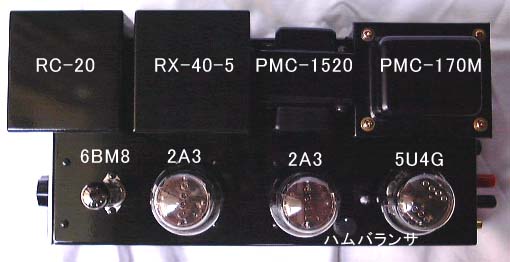
Front, rear, and side
view
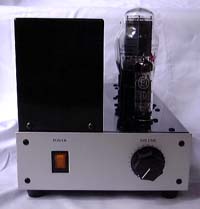
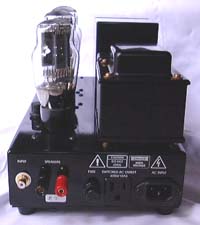
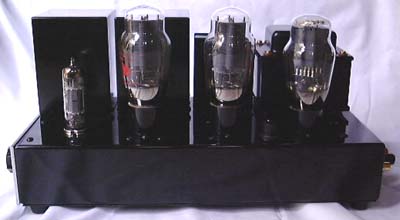
Internal wiring
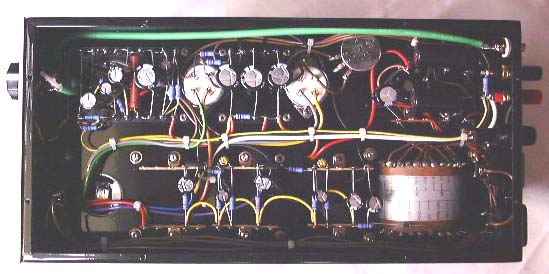
Instruction for building the amplifier
- We recommend one-point grounding at the fixing screw of 6BM8 socket. Two-point grounding that connects to ground also near the power transformer is not recommendable.
- Since the filament requires high power, the residual noise level varies depending on the ground wiring sequence. Observe the wire connecting sequence indicated in the wiring diagram to wire the ground line.
- Parts are very jammed near 6BM8. Pay attention not to have unwanted contact with each parts. For example, cover the lead wire of the parts with insulation tube (empire tube) and mount the parts carefully.
Impression on sound quality
It is a well-balanced and steady sound quality. Rhythms
performed by an orchestra are clearly heard. It may be well expressed to say
that the silence between the sounds can be clearly noticed. The established
reputation of 2A3 is soft sound. However, there is no particular softness in
the sounds. The impression is solid and massive sound based on well-developed
mid and low range. It is probably because of high power and transformer coupled
circuitry. Fortissimo in music is performed in a natural and unconstrained
manner.
High performance characteristics and good sound quality seem to be combined
quite successfully.
Measurement results
1. Input-output characteristics
Output increases linearly up to 20W.The waveform does not lose shape drastically beyond 20W and the output increases gradually up to about 25W.
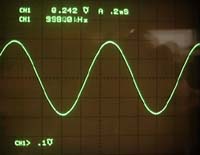
1KHz: 1W |
|
|
2. Frequency characteristics
Even without NFB, the frequency bandwidth is 10Hz to 20KHz (+0, -3dB) covering approximately the audible frequency range. Despite of transformer coupled 2-stage circuits and open secondary winding of interstage transformer, the attenuation characteristics are plain both at low and high ends. A little peak and dip are observed beyond 100KHz. However, since the amplifier's gain is reduced in this zone, this does not present a serious problem. The low-end attenuation at 10W output is due to the saturation of output transformer.
With 12dB NFB in minor and major loops, the bandwidth expands to 10Hz to 55KHz (+0, -3dB). Please look at the low-end characteristics at 0.1W and 1W output. They are not at all attenuated at 10Hz. Besides, there are no undesirable rise in audible frequency that is frequently observed in the transformer-coupled amplifier. Both low and high ends retain plain frequency characteristics also after negative feedback.
3. Square wave response
Load=6ohms
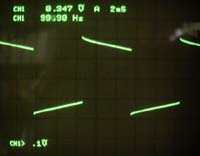
100Hz |
|
|
At 100Hz and 1KHz the waveforms are very fine. At 10KHz a slight ringing is observed due to peak and dip existing beyond 100KHz.
Load = 6ohms + capacitance (10KHz)
|
|
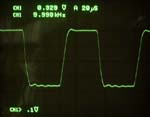 6ohms + 0.047uF |
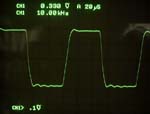
6ohms + 0.1uF |
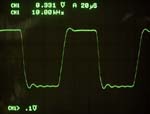
6ohms + 0.47uF |
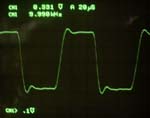
6ohms + 1uF |
Load = only capacitance (10KHz)
|
|
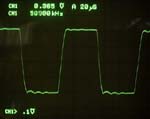
Only 0.047uF |
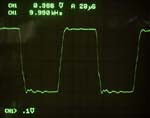
Only 0.1uF |
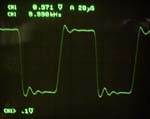
Only 0.47uF |
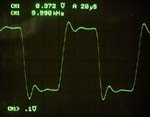
Only 1uF |
The output is quite stable with capacitance load.
4. Distortion factor characteristics
Without NFB
At 1KHz distortion canceling works effectively to obtain a very low distortion
factor in a wide range. At 100Hz and 10KHz distortion canceling is not
so significant as at 1KHz but the distortion level is excellent for non-NFB
amplifier. Around 12 to 15W, the operation switches from class A1 to A2
where the grid current flows. At this transition point, the distortion
factor presents a slight unevenness but it is negligible. Because of low
residual noise level, the distortion factor does not rise at low output
operation.
With 12dB minor + major NFB
The graph above represents an excellent low distortion
factors: 0.055% at 1KHz, 1W, 0.6% at 10W, and 3.2% at 20W output. If the
distortion factor at 10KHz is a little bit low, the performance should be
excellent. This reveals the limit of employing the interstage transformer for both
phase conversion and step-up.
Distortion component analysis by FFT
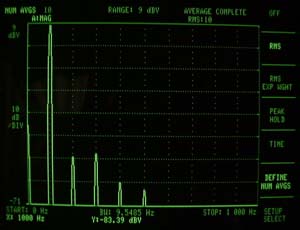
100Hz 1W |
|
|
|
|
Both 100Hz and 1KHz contain lower harmonic components
around 4th harmonic up to 1W and the higher the degree becomes the
lower the distortion, which presents excellent harmonic distortion
characteristics. Odd number degree harmonics are not particularly dominant
although this is a push-pull amplifier.
At output 15W, many higher harmonic components appear and odd number degree
components are more dominant than even number degree components. This
demonstrates well the characteristic proper to the push-pull amplifier.
5. Residual noise level
The residual noise level is 0.1mV. This is satisfactorily
low for the direct-heating power tube. The noise figure of 6BM8 is also
excellent.
6. Damping factor
Without NFB, the damping factor is low as 1.5. There is concern that it comes short of damping in low range for some kinds of speakers. 6dB major NFB increases the damping factor to 3.8, suitable for various kinds of speakers.
Parts to use
1. Vacuum tube
6BM8 is Ei brand, Yugoslavia. I forget where I bought at
what price. But at reasonable price anyway.
2A3 is made by Sovtek, Russia. I bought one pair at 6,500 yen at Classic Components at Akihabara. 5U4G is also made by Sovtek,
Russia.
Sovtek 2A3 & 5U4G and Ei 6BM8 are all at reasonable price, but they operate
very much satisfactorily.
2. Resistor
The resistors (2W, 5W) are incombustible (metal oxide film)
resistors. Its performance and stability may be suitable for the tube amplifier
operating in high voltage.
3. Capacitor
Electrolytic capacitors are all right with reasonable multipurpose small
size type. Capacitors made in recent years (within a couple of years) would
be better than old large size type. It is nothing unusual that multipurpose
capacitors having quick turnover of sales achieve better results than special
audio capacitors.
4. Transformer
Interstage transformer is Softone RC-20 and output transformer is Softone RX-40-5.
Power transformer is Noguchi PCM-170M and choke coil is Noguchi PCM-1520. Both are reasonable and good quality products.
5. Chassis
We use Softone MS-2.
This is a punched and painted easy-to-build chassis.
6. Wires
We recommend UL1015 standard wires . AWG22 meets the case for low current
path wiring and AWG20 for high current path wiring.
Too large size wire would be difficult for wiring.
7. Parts list
The table below shows the parts necessary for one unit of monaural
amplifier.
Only main parts are listed. Screws, wires, and small parts omitted in the table
are also necessary.
Please note that there are unknown or uncertain descriptions on some
manufacturers, shops, and prices.
|
Parts No. |
Spec/model No. |
Type |
Brand |
Shop |
Price in yen |
|
C01 |
50P |
Dip mica capacitor |
CR |
90 |
|
|
C02 |
1000uF16V |
Small size radial electrolytic |
Nichemi |
||
|
C03 |
390P |
Dip mica capacitor |
CR |
90 |
|
|
C04 |
100uF400V |
Small size radial electrolytic |
Unicon |
Softone |
180 |
|
C05 |
10uF350V |
Small size radial electrolytic |
Nichemi |
||
|
C06 |
47uF250V |
Small size radial electrolytic |
Unicon |
Softone |
|
|
C07 |
47uF250V |
Small size radial electrolytic |
Unicon |
Softone |
|
|
C08 |
10uF350V |
Small size radial electrolytic |
Nichemi |
||
|
C09 |
10uF350V |
Small size radial electrolytic |
Nichemi |
||
|
C10 |
47uF250V |
Small size radial electrolytic |
Unicon |
Softone |
100 |
|
C11 |
47uF250V |
Small size radial electrolytic |
Unicon |
Softone |
100 |
|
C12 |
10uF350V |
Small size radial electrolytic |
Nichemi |
||
|
C13 |
47uF250V |
Small size radial electrolytic |
Unicon |
Softone |
100 |
|
C14 |
100uF400V |
Small size radial electrolytic |
Unicon |
Softone |
180 |
|
C15 |
100uF400V |
Small size radial electrolytic |
Unicon |
Softone |
180 |
|
C16 |
100uF400V |
Small size radial electrolytic |
Unicon |
Softone |
180 |
|
C17 |
22uF450V |
Small size radial electrolytic |
Nichemi |
||
|
C18 |
10000uF16V |
Small size radial electrolytic |
Tohshin |
Sengoku |
150 |
|
C19 |
10000uF16V |
Small size radial electrolytic |
Tohshin |
Sengoku |
150 |
|
D01 |
1N4007 |
1000V1A diode |
GI |
Sengoku |
20 |
|
DB01 |
CP3508 |
8A diode bridge |
|
Akizuki |
|
|
DB02 |
CP3508 |
8A diode bridge |
|
Akizuki |
|
|
Q01 |
2SK1758 |
500V Nch MOS-FET |
NEC | ||
|
Q02 |
2SK1758 |
500V Nch MOS-FET |
NEC | ||
|
R01 |
100K/2W |
Incombustible (metal oxide film) resistor |
Takman |
Sengoku |
20 |
|
R02 |
10K/2W |
Incombustible (metal oxide film) resistor |
Takman |
Sengoku |
20 |
|
R03 |
1.8K/2W |
Incombustible (metal oxide film) resistor |
Takman |
Sengoku |
20 |
|
R04 |
240/2W |
Incombustible (metal oxide film) resistor |
Takman |
Sengoku |
20 |
|
R05 |
100K/2W |
Incombustible (metal oxide film) resistor |
Takman |
Sengoku |
20 |
|
R06 |
1K/2W |
Incombustible (metal oxide film) resistor |
Takman |
Sengoku |
20 |
|
R07 |
75K/2W |
Incombustible (metal oxide film) resistor |
Takman |
Sengoku |
20 |
|
R08 |
10K/5W |
Incombustible (metal oxide film) resistor |
|||
|
R09 |
100/2W |
Incombustible (metal oxide film) resistor |
Takman |
Sengoku |
20 |
|
R10 |
8.2/2W |
Incombustible (metal oxide film) resistor |
Takman |
Sengoku |
20 |
|
R11 |
22/2W |
Incombustible (metal oxide film) resistor |
Takman |
Sengoku |
20 |
|
R12 |
22/2W |
Incombustible (metal oxide film) resistor |
Takman |
Sengoku |
20 |
|
R13 |
330/2W |
Incombustible (metal oxide film) resistor |
Takman |
Sengoku |
20 |
|
R14 |
10K/2W |
Incombustible (metal oxide film) resistor |
Takman |
Sengoku |
20 |
|
R15 |
5.1K/2W |
Incombustible (metal oxide film) resistor |
Takman |
Sengoku |
20 |
|
R16 |
75K/2W |
Incombustible (metal oxide film) resistor |
Takman |
Sengoku |
20 |
|
R17 |
27K/2W |
Incombustible (metal oxide film) resistor |
Takman |
Sengoku |
20 |
|
R18 |
10K/2W |
Incombustible (metal oxide film) resistor |
Takman |
Sengoku |
20 |
|
R19 |
5.1K/2W |
Incombustible (metal oxide film) resistor |
Takman |
Sengoku |
20 |
|
R20 |
75K/2W |
Incombustible (metal oxide film) resistor |
Takman |
Sengoku |
20 |
|
R21 |
27K/2W |
Incombustible (metal oxide film) resistor |
Takman |
Sengoku |
20 |
|
R22 |
5.1K/2W |
Incombustible (metal oxide film) resistor |
Takman |
Sengoku |
20 |
|
R23 |
8.2K/2W |
Incombustible (metal oxide film) resistor |
Takman |
Sengoku |
20 |
|
R24 |
18K/2W |
Incombustible (metal oxide film) resistor |
Takman |
Sengoku |
20 |
|
R25 |
27K/2W |
Incombustible (metal oxide film) resistor |
Takman |
Sengoku |
20 |
|
R26 |
2K/2W |
Incombustible (metal oxide film) resistor |
Takman |
Sengoku |
20 |
|
T01 |
RC-20 |
Interstage transformer |
Softone |
Softone |
10800 |
|
T02 |
RX-40-5 |
Push-pull output transformer ВTKohms40W |
Softone |
Softone |
10800 |
|
T03 |
PMC1520H |
Choke coil |
Noguchi |
Noguchi |
4500 |
|
T04 |
PMC170M |
Power transformer |
Noguchi |
Noguchi |
7900 |
|
V01, V02 |
6BM8 |
Ei |
|||
|
V03 |
2A3 |
Sovtek |
|||
|
V04 |
2A3 |
Sovtek |
|||
|
V05 |
5U4G |
Sovtek |
|||
|
VR01 |
100KA RV24YN |
Single potentiometer |
Cosmos |
350 |
|
|
VR02 |
50B/2W RV30YN |
Single potentiometer |
Cosmos |
500 |
|
|
VR03 |
50KB |
Small size single potentiometer |
Cosmos |
||
|
VR04 |
50KB |
Small size single potentiometer |
Cosmos |
||
|
9-pin MT socket 1 piece |
QQQ |
100 |
|||
|
US socket 1 piece |
QQQ |
100 |
|||
|
UX socket 2 pieces |
800 |
||||
|
4L1P lug 6 pieces |
|||||
|
2L1P lug 1 piece |
|||||
|
2A fuse 1 piece |
|||||
|
MS-2a chassis |
Painted and punched, with exterior parts and ammeter |
Softone |
Softone |
15000 |
